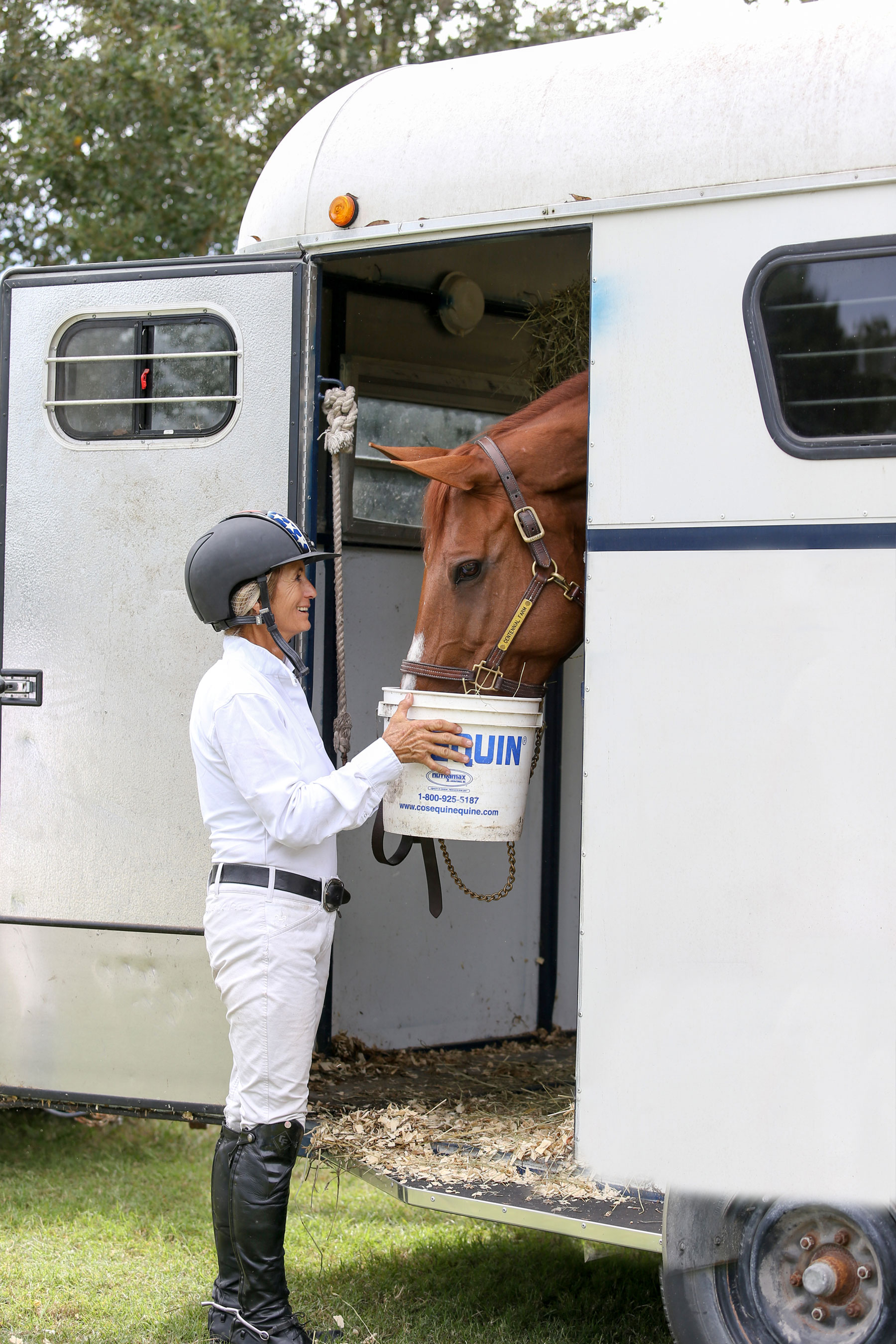
Last month I walked you through a record-keeping routine to improve your partnership with your horse. This month, I’m going to ask you to take a leap of faith with me by turning one of your next shows into what I call a “reprogramming” or “training” show. I will tell you how to plan every step of this competition, from the small yet important tasks in its lead-up to the invaluable post-show analysis. As these pieces fall into place, you will develop a new strategy for arriving at the in-gate calm, relaxed and ready to rise to the occasion, whether you’re at a one-day or multiday show. This new peace of mind will, in turn, produce more consistency in your performances. That’s what real riding success is all about—not necessarily winning all the time but placing consistently, show after show.
For this particular experiment, choose a show in which you won’t mind dropping down a level from your ordinary competition level. It’s much easier to focus on implementing new techniques when you’re riding at a lower level.
Your motto for this training show will be “think ahead!” By anticipating and taking care of every detail in a timely manner, you can minimize the chaos and stress that distract you from performing your best. Just as we know that human brains aren’t equipped to text and drive at the same time, we know we won’t do our best if we multitask all the way up to the moment that we enter the ring. Instead, your goal is to make as many horse-show tasks as possible so routine that they become as instinctive as walking. Careful planning also will allow you to create space in your schedule to take a breath, relax and focus on your performance. And, should something unexpected occur—a weather-related change in schedule, for example—if you’ve already addressed every lingering question in your mind, you’ll find it easier to transition from your ideal Plan A to an acceptable Plan B.
The Prize List, Rule Book and Entry Form
Begin developing your new strategy at least six weeks before the show. If you don’t receive the prize list in the mail, find it online and print it out for your show book (more on this later). Then read it cover to cover. Take note of the opening and closing dates for entries, the names of the judge(s) and course designer(s), the classes that interest you and any additional rules or restrictions that might apply to you.
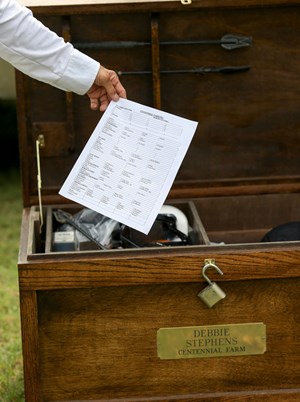
Pay close attention to all of the other show-specific rules and details, which may be different from ones you’ve experienced at other shows. For example, water may not be provided at certain one-day shows, so you’ll need to bring it with you. The stabling may not include tent flaps or overhangs, in which case you’ll need to plan how to keep your horse, stall bedding and equipment dry if there’s rain. If such stabling details aren’t spelled out in the prize list, call the show stable manager—the name and number should be on the prize list. Some shows prohibit dogs on the showgrounds; others don’t allow you to drive golf carts or motorcycles around the barns. If you were counting on using a motorized form of transportation to get to and from rings, the latter rule will require some serious schedule rethinking. Also be sure you understand all the qualification rules that apply to you as well as any restrictions on cross-entering classes.
Next, pull out the rule book that will apply to this show, according to the information specified on the prize list. For example, if the show is U.S. Equestrian Federation-recognized, it will be run under USEF rules. Read every part of the rule book that governs your discipline and age group. The importance of this is not stressed enough in our sport. As with any other sport or game (even solitaire!), you need to know the rules to play the game. Some of them might even surprise you. Did you know that under USEF rules jumper riders can be eliminated for carrying a cell phone in the show ring?
The rule book will describe everything from accepted rider attire, tack and equipment to the manner in which each class is run. For instance, in some jumper classes, you proceed to the jumpoff round immediately after riding your first course; in others, you leave the ring and ride the jumpoff course later. It also will explain the instructions the judge might give you (during an equitation class) and describe how many points you’ll earn for choosing bonus options, such as the bigger fence options in a derby class.
Chapter 4 of the General Rules section in the USEF Rule Book lists substances and combinations of substances that are prohibited from use immediately before or during USEF competitions. This is where knowing the details of your horse’s care that I discussed last month comes into play. Ask your vet to help you ensure that any medication your horse receives, including herbal/alternative treatments, which sometimes produce positive test results, fully complies with these rules. This includes topical anti-inflammatory products, which can be illegal to use in combination with Banamine® under USEF rules.
Some substances remain detectable in blood and urine samples as long as 90 days after administration. Be careful! Today’s officials are not fooling around—they accept no excuses. If you have any doubts about the legality of a particular medication, contact the USEF at medequestrian@aol.com or call its hotline at (800) 633-2472. The office responds to emergency calls 24/7.
The rule book is packed with plenty of other information that can improve your understanding of your particular discipline. For example, if you’re a jumper or eventer, learning the definitions for “time limit,” “time allowed” and “optimum time” is essential, as is knowing the different speeds used to calculate these numbers at your level. Make notes of any important information like this that you might need to review during the competition. For items you’ll refer to frequently, such as the definitions of different jumper classes or metric conversions of fence heights (you can find a table of these in the USEF Rule Book or crunch the numbers with one of the free conversion tools online), photocopy sections from the Rule Book or draft simple charts on your computer. Then laminate these “cheat sheets” and bring them to every show.
Once you’ve read the entire prize list for the show and reviewed all of the pertinent rules, carefully fill out the entry form. Do this well in advance of the entry closing date—preferably on the opening day if entries may be limited—to avoid any last-minute stress and mistakes. Determine what level of classes would suit you and your horse best, and then sign up for the level below that. Double-check that you’ve filled in every blank on the entry form and included all of the necessary payments and required materials. Then make a photocopy of the completed form to save for your records.
Mail your entry using a service that can guarantee delivery and notify you when it’s received, such as certified USPS mail, FedEx or UPS. If you don’t receive confirmation that it was delivered, track it to be absolutely sure that it was. Never assume that the show received your entry.
Create a Show Book
Now put together a show book similar to the record book I described last month. Start with a loose-ring binder. Depending on how often you show, you may want to make a new book every year (if you do, be sure to save the old ones to use for reference). Create a new divider for each show venue and add the following items:
• the prize list
• useful notes/charts from the rule book
• a copy of your completed entry form, along with the delivery confirmation
• details about your lodging reservation—confirmation number, phone number, address, directions, etc. Again, make this reservation early to be sure there are no last-minute surprises.
• printed directions to the show (I use MapQuest), even if you plan on using a GPS navigator—it never hurts to have a backup plan
• names and locations of convenient, easily accessible truck stops along your route, if your trip will be longer than three hours. There are several useful “fuel finder” sites online. Plan to stop at least once every three hours to offer your horse water.
• any other information that might be useful en route to the show should there be an emergency, such as names of local veterinarians and alternate roads to avoid traffic jams
• names and contact information for any businesses you have contracted to supply you with feed, bedding, etc., on the showgrounds. If you are ordering feed, be sure it is the same brand/type that you use at home. Switching feeds suddenly at a show may upset your horse’s digestive system.
• a chart for tracking your horse’s temperature, similar to the chart you keep in your record book at home.
Final Pre-Show Preparations
In the week leading up to the show, give yourself plenty of time to check and pack your equipment and double-check your plans. I operate with Murphy’s Law in mind: If it can go wrong, it will. So dot all the i’s and cross all the t’s. Here are some great time-saving/disaster-prevention tips:
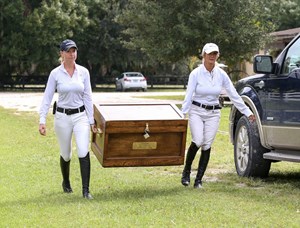
• Design and laminate a stall card to hang on your horse’s door at the show. In large, bright letters, include his name, your name and your emergency contact information. This might be a lifesaver if someone passes his stall late at night and notices that he has escaped, gotten cast in his stall or begun to show signs of colic.
• Run through your tack- and equipment- safety checklist (described in last month’s article) to be sure all of your gear is safe and ready to go.
• Call the show stable manager to ask for your horse’s stall and barn number. Also ask for general directions to his stall, so that you won’t have to hunt down a map when you arrive on the showgrounds.
• If you ordered feed or bedding, call the supplier to confirm when and where it will be delivered.
• Two days before the show, begin administering daily oral electrolytes to encourage your horse to stay hydrated. Dehydration is a serious concern in traveling and competing horses, especially as it can lead to colic. I prefer using the tube form of electrolytes, so that I know exactly how much my horse ingested. I also always provide a free-choice salt block in his stall at shows and carefully monitor its size over time. If your horse is a picky drinker, add a little bit of Gatorade to his water on the road and at the show. (Test this at home first to be sure he likes it.)
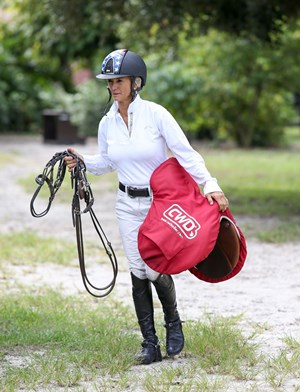
• Load all of your equipment the night before your departure, even if you’re traveling the day before the show begins. Also, unless you ship your horse regularly, practice loading him onto the trailer. Park it in the same location where it will be the next day and load him with the same buddies he’ll be traveling with (or alone, if that will be the case). Give him treats when he gets on to reinforce his good behavior.
This is a great way to set the tone for the entire show. If you leave the packing and loading for departure day, there’s always the chance that you’ll sleep through your alarm, the weather will turn nasty or your horse will suddenly decide that he doesn’t like this particular loading scenario. You want this departure to be as simple and hassle-free as possible, not a rushed fight to the finish that shortens everyone’s tempers. Pad your departure time by an extra hour or so to allow for other unpredictable delays. For example, if your horse gets a little frantic in the trailer, you’ll be glad to have that extra time to settle him in when you arrive at the show.
• The night before the show begins, whether you are traveling there the next morning or have already arrived on the grounds, check the number of competitors and order of go for each of your classes. This is usually available online—check your prize list for details. Then, use this information to estimate what time you’ll ride. For jumper classes, I usually figure on about 30 rides an hour, plus 10 minutes per course change and 10 minutes per course walk. Make a rough schedule for the day: when you will walk your courses, what time you will tack up, when you will start warming up, when you will arrive at the in-gate, etc. You’ll refine this schedule further when you arrive on the showgrounds—more on that later.
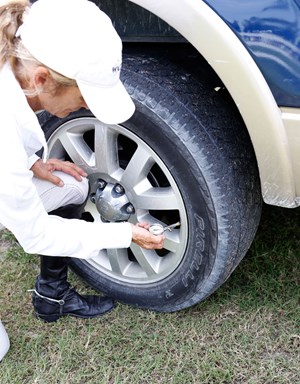
• This should go without saying, but always do a final vehicle check: Are your tire pressures equal? Brake/indicator lights working? Is your hitch properly connected? Fuel tank filled? Never take anything for granted when shipping your horse—even if you’re doing it commercially, in which case be sure to hire a reliable company with an excellent safety record.
• Finally, just before you load your horse, take his temperature and record it in your book. Take it again about an hour after you arrive on the showgrounds and then every day after that. This is a very important indicator of his health. Consult your veterinarian or the show veterinarian if you notice any changes.
Settling In
When you arrive at the show, your first priority should always be your horse. After unloading, hand-walk him around the grounds and observe his behavior closely. Is he relaxed, excited, distracted? Even very experienced campaigners are sometimes uneasy at certain venues. Knowing your horse’s mental state will help you plan your strategy for the rest of the show.
Before putting him in his stall, inspect it thoroughly. Look for anything that might be unsafe, such as loose boards or protruding nails. Competitors using the stall during a previous show may have made it into a tack room, hammering nails and hooks on the wall for hanging equipment.
Next, go to the show office to collect your number. Then take time to familiarize yourself with the rest of the showgrounds. Where are the bathrooms and food vendors? Where is the farrier station? Where is the best place to longe? If this isn’t clearly marked, ask the show manager. Which warm-up arenas look best? Check the footing of all the competition and schooling areas. Is it too hard? Too deep? Too rocky? If you have serious concerns, bring them to the attention of the show organizer. An organizer who is truly committed to protecting the horses and riders will try to accommodate reasonable requests. If changes aren’t made to your satisfaction, you always have the option to leave. Never jeopardize your horse’s welfare.
As you explore the grounds, time how long it takes to walk from the trailer or barn to the warm-up ring and from the warm-up ring to the show ring. This will help you plan your schedule more accurately. Also work out where the angle of the sun will be at different times of the day, so you can predict where the spookiest shadows might be in the ring at your ride time.
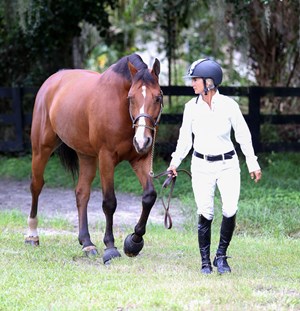
Ideally, you will arrive at the show early enough to ride your horse once in the morning to get a read on how he’s feeling. If you arrive the day before and have time, ride him once then and again early the next morning. If he seems especially energetic, put him on the longe line for 10 or 15 minutes before you ride. Longe him in a controlled manner—always with a bridle, never a halter. Even with a chain, a halter won’t prevent a horse from breaking free and becoming a danger to himself and others. If he’s bursting at the seams, let him buck. But otherwise, use plenty of walk–trot/trot–walk transitions and ask him to travel at a normal pace. The goal is not to wear him out but rather to take just enough of an edge off so that you can get his attention when you’re in the saddle.
Take Notes
For the rest of this training competition, make a point to observe and record everything. Before your ride, if you have time to watch other riders in your class (or in the previous class if the course is the same as or very similar to yours), take note of what jumps cause problems, how the striding works in the lines and whether it seems easy or hard to make the time. Adjust your riding plan accordingly.
Also gather information about the judge’s style. In subjective classes (hunter, equitation and dressage), look for trends in his or her preferences. What do you notice about the top-placed horses and riders? Are the horses quiet and slow off the ground or do they travel with a lot of pace? How flexed are they in the bridle? Are the riders sitting in the saddle or riding more in two-point? Does the judge seem to prefer flying changes over simple changes? Make notes of all of these observations in your show book for future reference.
Familiarize yourself with the course designer’s style as well. At the end of the show, re-walk any sections of the courses that you found challenging. Take pictures of the courses and make notes about the distances between fences, the materials and types of fences used and any other salient features. Put all of this information in your show book.
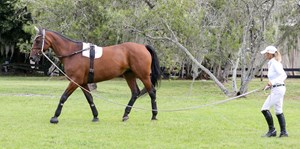
Most importantly, take notes about your and your horse’s performances. Did you have trouble riding a particular part of the course? If so, describe everything about it (jump dimensions, etc.) in your book and plan to practice that question at home. Was your horse unusually spooky about something hanging on the sides of the arena? Do you think you jumped too high or too low in your warm-up? Did you leave yourself enough time during the day to take a breath and relax? Just as I told you to connect the dots in your horse’s care at home, analyze every aspect of this training show to figure out what you can change in your future show strategy.
If you have a bad day, that’s an even better reason to review your show strategy. Imagine you studied as hard as you could for the SATs, then went in and felt lost by the third question. Instead of giving up the idea of going to college just because of that one bad score, a better solution would be to regroup, find a new study guide and retake the test. Similarly, by studying every detail of your show strategy and performance, you can shape a plan that maximizes your success at future shows.
Show jumper Debbie Stephens has graced the grand-prix circuit for more than three and a half decades. After graduating from Syracuse University, she took a job working for New York horseman Ted Ralston. Years later, she started Centennial Farm with her friend Bill Glass. She won her first grand prix in 1980 in Cleveland on the gray stallion Abdullah. In 1982, Debbie set the ladies outdoor high-jump record by clearing 7-foot-8 with Spindletop Rocky Raccoon. Since then, she has won countless grands prix and represented the U.S. in many international competitions. Her long list of successful mounts includes Volan, VIP, Poor Richard, Texas T, Blind Date, Don Carlos, Pacifica, Chappie, Callaway 4 and Cosequin’s CEO among many others.
Debbie is now based at Centennial Equestrian Farm in Tampa Bay, Florida. She continues to teach, train and hold her own in the grand-prix ring.
Sidebar: The Learning Never Ends
Even with my decades of experience, I still feel that there’s always something new to learn. This summer, I was fortunate enough to travel to France to attend the Alltech FEI World Equestrian Games. I watched every ride carefully from the grandstands and took notes. In the lead-up to one of eventual individual bronze-medal winner Beezie Madden’s rides, I noticed that horses were spooking at a shadow on one particular wall. I was prepared to send a text to warn Beezie about this while she was warming up, but the angle of the sun changed a few rides before hers and the shadow disappeared.
A few days later at home, I taught a beginner rider and realized that some of the same lessons I was teaching her had proven just as critical for the elite WEG riders. It’s all about making a plan, having a goal—and taking notes!
Sidebar: Ringside Rescue Pack
At every show, I fill a backpack with anything I can imagine needing in the warm-up ring: a brush and towel, extra bit, girth, gloves and stick, different types of spurs, a raincoat, treats and a sheet for my horse. This can save you a frantic, last-minute sprint back to the barn just before your ride time. Don’t try to fit your entire tack room in this bag; just ask yourself, “What if … ?” Also be sure to label the bag clearly with your name and phone number.
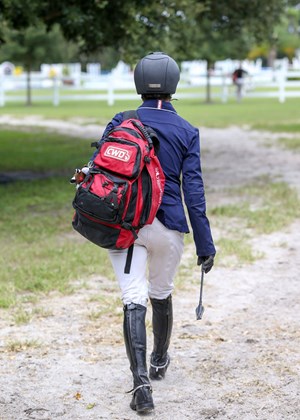
Read Debbie’s other articles in this series: Track Your Horse’s Health and Reach New Goals With a Positive Attitude
This article originally appeared in the February 2015 issue of Practical Horseman.










